rhizomes.06 spring 2003
Opaque Melodies that Would Bug Most People: a Short History of Dislocation
in Six Tracks
Darren Tofts
[1] I'm sure that everyone can think of something in the name of culture that continues to trouble them, infuriates them in its refusal to resolve into meaning, coherence and closure. I'm talking about those moments of aesthetic engagement with opaque melodies that would bug most people. [1] I'm talking about a poetics of dislocation. In referring to a poetics of dislocation, rather than pointing to a historical epoch characterised by dislocation, I am citing an ongoing continuum, a trans-historical, para-cultural sensibility, or, as Aristotle would have it, a way of doing things.
[2] Dislocation in the arts has a long history. It is a history that converges with our contemporary informatic moment: a quantum, post-media moment when you can be here and there at the same time, a vectoral moment in which there is no longer any there, there, to begin with. In the age of the internet, location itself has become mobile, decentred, fragmented. Communications networks have modified the way we relate to locality and presence. As Scott McQuire has noted, we are still struggling to come to terms with the strange valencies that telepresence brings with it, even as we spend more and more time in cyberspace (McQuire, 2002). New media artists have also been exploring the perverse locutions of dislocation for some years now and their work, like the work of new media theorists, actively engages with the emerging unconscious of the cyber age: and, yes, it is indeed an unconscious structured like a language, this unsettling "grammar for being elsewhere". [2]
[3] I have been interested in exploring the historical unconscious of this unconscious for many years now, but principally in two books, Memory Trade. A Prehistory of Cyberculture, in collaboration with artist Murray McKeich, and Parallax, a collection of essays on art, culture and technology. But these works weren't actually books. They were masquerading as books, and were in fact examples of one of the most prominent contemporary forms of dislocation, the compilation tape. True compilations, like collage, are eclectic, bringing together items drawn from different contexts, different locations, into a contextual dislocation. That is, to dislocate is not to separate or disintegrate, but rather to re-locate something in another context, often, as in collage, in surprising, even disturbing ways. Montage, as distinct from collage, is perhaps less dramatic, in that it provides links that are absent in collage; so, for example, as distinct from my compilation tape, montage synthesises the thematic "best of" or "greatest hits", in which a particular artist or style provides the contiguity lacking in the true or eclectic compilation (for example the best of funk, punk, or, god forbid, Andrew Lloyd Webber's greatest hits). Media cross-dressers, these works were assemblages of ideas pertinent to me in thinking, in the former, about the foundations of cyberculture in alphabetic literacy as a technology of distance and, in the latter, of new media aesthetics as a continuation of the historical avant-garde, whereby Stéphane Mallarmé, Marcel Duchamp and John Cage are contemporaries of digital artists rather than models the latter would want to succeed.
[4] This essay, equally a masquerade, is the most recent title in my series of explorations into the co-evolution of cyberculture and new media arts practice. Like any compilation tape, it is un-apologetically selective, provisional and highly idiosyncratic. It is made up of tracks that have a resonance for me within a specific act of critical speculation about dislocation and aesthetics. In thinking about the tracks I would include on my latest release, I wanted to bring together selections that would underscore an attitude to dislocation as a way of doing things, or, to use Suzi Gablik's words, a form of aesthetic making (Gablik, 1995). In particular, I wanted to counterpoint a historical tendency towards aesthetic dislocation that is specifically pertinent to an understanding of the contemporary phenomenon known as new media art. This tape can be played on monaural or stereophonic equipment.
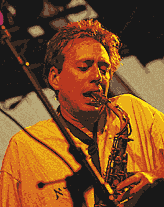
figure 1: John Zorn
Track One: "Never Sweet or Satisfied"
[5] One of the axioms of cyberculture is that the speed of telecommunications is dramatically impacting upon our senses, creating a hyper-sensory cognitive relationship to the world that is at once influenced by speed and at the same time attuned to it, that is turned on to it. John Zorn, the American experimental jazz composer, is an artist whose work dramatically represents this sensibility. Steeped in the history of American experimental music -- John Cage, Charles Ives and Harry Partch -- Zorn's early work in the 1970s was already attuned to questions of atonality, noise, genre transgression and disjunctive structure. Since that time he has actively experimented with the creation of discrete sonic moments that can be combined together. These moments, along with the principles of combination that bring them into juxtaposition, do not prioritize original composition over pastiche or sample, ambient noise or snippet of radio. In this it's no accident that one of Zorn's formative influences was Jean-Luc Godard, whose signature jump-cut represented for Zorn the collision of isolated, dislocated moments that he was interested in exploring in his composition and performance.
[6] When I first heard Zorn's music in the mid '80s (it was his tribute album to Ennio Morricone, The Big Gundown), it had a profound and urgent impact on me. In fact, as they say in the Sutras, it knocked my fucking socks off. In retrospect, I now realize I was listening to one of the first examples of music produced by and for a hypermediated sensibility. At the time, I remember feeling that this guy was someone who had watched lots of television and bulk cartoons to boot. Even before the information age, mass media had produced its own kind of hypermediated sensibility and Zorn's music of the '80s, on the cusp of the computer revolution, evidenced the convergent and co-evolutionary, rather than revolutionary nature of the poetics of dislocation (it's worth remembering in this context that McKenzie Wark's seminal 1994 text Virtual Geography, in which he outlined his familiar vectoral model of media, was concerned with television and not the computer network).
[7] Concentrational entropy was said to be one of the pathological conditions of watching too much television, one of its more famous sufferers being Homer Simpson. For Zorn, however, this is not so much a condition to bemoan, but rather a recognition of the complexity of media flows and the surprising flexibility of the ways in which we have adapted to them. As he indicated in the liner notes to his 1988 recording Spillane:
I've got an incredibly short attention span. In some sense, it is true that my music is ideal for people who are impatient, because it is jam-packed with information that is changing very fast. But it also takes a little patience because if you get to something you don't like, you have to wait ten seconds or so until it turns into something else. Pacing is essential. If you move too fast, people tend to stop hearing the individual moments as complete in themselves and more as elements of a "cloud effect". In fact there are sections in Spillane that are two or three minutes long. Here, I've offset the speed with something slow -- like the rain scene at the end of the piece -- to give the speed perspective and meaning (Zorn, 1988).
A self-proclaimed media freak, growing up in New York City, watching movies and TV and buying hundreds of records, Zorn acknowledges the heterogeneous nature of the media that he has avidly consumed: "There's a lot of jazz in me, but there's also a lot of rock, a lot of classical, a lot of ethnic music, a lot of blues, a lot of movie soundtracks. I'm a mixture of all those things" (Zorn, 1988). Zorn's music combines a diverse range of musical styles, from be-bop, bossa nova and country and western, to reggae, hardcore, thrash-metal and free-form jazz. At once dislocated and dislocating, it is, as one commentator has noted, "[a]brasive, loud, fast, unpleasant, disjunctive... never sweet or satisfied in the conventional sense" (McNeilly, 1995, 3). Describing Zorn's music as an "ugly beauty", the same writer, in an essay on Zorn published in Postmodern Culture, cites Linda Hutcheon's concept of postmodern parody to theorize Zorn's practice. While sensitive to the opaque, infuriating aspect of Zorn's replication of "mass-media noise making", he adds that it can and does "lead to a vision of interconnectedness" (19). This ambivalence towards dislocation reflects one of the truisms of the information age: and that is, whether listening to John Zorn's music or communicating with remote others via email or IRC, interconnectedness is very much in the eye and ear of the beholder.
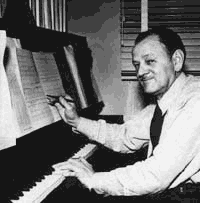
figure 2: Carl Stalling
Track Two: "You Ought to Be in Pictures"
[8] One of the great, unsung precursors of non-linear editing and compositing is the novelist Vladimir Nabokov. Nabokov used a system of file cards to create his plot structures, shuffling and shifting pieces of detail here and there to endow the linear technology of the book with temporal syncopations akin to music; dislocations that would align dramatic and surprising thematic moments. Like Nabokov, John Zorn also used file cards as a system of composition, to exploit the unexpected tensions of adjacent moments, of sound being pieced together on the principle of juxtaposition rather than linear, thematic development: that is, the Forsterian concatenations of "and then, and then, and then". I've absolutely no idea whether Zorn was familiar with Nabokov or not, but he admits to an important influence on his approach to structure, Carl Stalling.
[9] Throughout the 1940s and 1950s, Carl Stalling wrote the music for the classic Warner Brothers cartoons that John Zorn was weaned on. "At that time", he notes with the certainty of conviction, "neither Cage nor Harry Partch came close to what Stalling was doing". Zorn described Stalling's music as a "constantly changing kaleidoscope of styles, forms, melodies, quotations", adding that his music, when listened to in isolation from the image, constantly throws you off balance, "yet there is something strangely familiar about it all" (Zorn, 1988) (dislocation, once again, as both dis-inter and integration). For Zorn, Stalling's significance was in his shift from traditional rules of composition, such as the development of theme and variations on a theme, etc, to following the visual logic of the action on screen, which included rapid shifts in tempo and style, as well as the sonic description of often frenetic visual events.
[10] The aggressive staccato attack of Stalling's sublime compositions is a product of working in bits at a time, in bits of time -- persistence of vision, we should not forget, is the measure of our interactive role in animation, which deals in discrete frames of subliminal difference. Norm McCabe, an animator at Warner Brothers during Stalling's time there, provides a fascinating insight into how Stalling worked:
Generally speaking, Stalling was in on the film almost from the beginning. After the storyboard was finished, we'd take the whole thing in there for a little session with Carl and talk it all over first. He was never short of musical ideas, but still might ask if I had a suggestion for a piece of music in a given sequence, and he'd really listen. Or else he'd look at the storyboard and say, "Let's put this scene on 8's, or on 10's, or on 12's," or whatever -- meaning using a 8-, 10-, or 12-beat for particular character actions. By the end of the session, Carl would have set the tempos for the entire cartoon (McCabe, 1990).
Stalling actually composed in a manner that Zorn was many years later to call "block structure" (Zorn, 1988). Consistent with the co-evolutionary nature of the aesthetics of dislocation, we can read John Zorn's account of his own method of composition as a palimpsest of Carl Stalling's method: I developed my [way of putting music together] very early on -- the idea of working with blocks. At first maybe the blocks were more like just blocks of sound... noisy improvisational statements, but eventually it came back to using genre as musical notes and moving these blocks of genre around... (McCabe, 1995, 8).The idea of block structure -- and specifically of the block of sound in and of itself -- occupies an important place in the aesthetics of avant-garde practice, as Deleuze and Guattari have noted. In referring to the music of Pierre Boulez in A Thousand Plateaus, they emphasize that the sound block has no point of origin, "since it is always and already in the middle of the line; and no longer has horizontal and vertical coordinates, since it creates its own coordinates". Carl Stalling's block structure is an example of what Deleuze and Guattari call a "multilinear system", a system that dismantles, disrupts, dislocates: a system abounding in new media (Deleuze & Guattari, 1987, 296). It only dawned on me recently that when I first started teaching my students basic html in the early 1990s, using nothing more than Microsoft notepad and a little code, I was introducing them to something more than the language of new media. In the structural logic of an htm file, which is an assemblage of separate, different file types (htm files, jpgs, avis, etc), simply linked together by a principle of connection, these students were tracing a mode of avant-garde composition that had previously been practiced in relation to experimental music and animation.
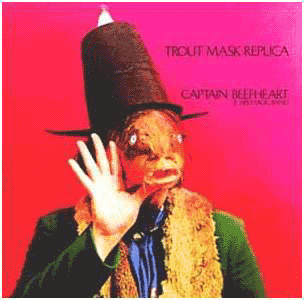
figure 3: Captain Beefheart's Trout Mask Replica
Track Three: "Uh Shit, How Did That Harmony Get in There?" [3]
[11] How far can dislocation be pushed? At what point does something become truly un-listenable, un-watchable, unbearable? Is there such a point? The history of the avant-garde abounds with wonderful stories of such distress, from the riots at the first performance of Stravinsky's Rite of Spring, to the woman who interrupted one of John Cage's performances crying out, "John, I love you, but I can't take any more of this". One of my students many years ago told me that she had thrown her copy of Italo Calvino's If On A Winter's Night A Traveler into the bin and demanded to know if I was deliberately trying to mess with her mind. "I wish I could claim the credit", was my unwelcome reply.
[12] When Captain Beefheart and His Magic Band released their fourth album, Trout Mask Replica in 1969, it engendered the kind of response that I am getting at here, the sense of being a bout de souffle, breathless, at the end of the tether. "A common response to this album", writes one commentator, "is initial hatred" (Sherill). "Some may find this album so disturbing as to be unlistenable", wrote another (Seigal, 1983).
[13] Like Zorn and Stalling, Beefheart was a genre transgressor, drawing on and bringing into dense, frenzied collision a dizzying array of musical styles and influences, from free-form jazz, Delta blues, African chant rhythms, to squealing noise for its own sake. While the effect is much coarser than Zorn or Stalling, the music onTrout Mask Replica nonetheless emerges out of a similar vision of calculated discordance, determined dislocation. In an attempt to redress what he called "public incomprehension", Lester Bangs, reviewing the album in Rolling Stone, described Beefheart as "the only true dadaist in rock" and asserted that Trout Mask Replica, "difficult and rough as it is, proceeded from a unique and original consciousness" (Bangs, 1969). Sounding very much like Samuel Beckett in his spirited 1928 essay on James Joyce, chiding the whingers who found Finnegans Wakeunreadable, [4] Bangs drew attention to the disciplined nature of the album's recalcitrance, or what another critic referred to as the "manifestation of forethought and precision masquerading as anarchy". Another masquerade, you will note, and another instance of dis-integration as integration.
[14] In this respect Trout Mask Replica takes all available musical genres and foregrounds them as genre through abrupt and aggressive juxtaposition. This is the kind of "organized violence" that Roman Jakobson had in mind when he was theorising literariness, that quality of writing that makes something literary rather than simply linguistic. Dick Larson, reviewing Trout Mask Replica in 1969, described how Beefheart and his band "tear and slash at the guts of their music, ripping its lungs out, grinding and crushing the bones, then pull it all together again in a couple of bars" (Larson, 1969). Beefheart defamiliarises and revives the "tired-out bullshit conventions of every contemporary musical field", Larson asserts, noting that the "real value of the music is its texture, its depth, and the subtlety of reaction between rhythms and melodies -- harsh as they may seem". And this is the point about organized violence, certainly as Jakobson had theorized it. Literariness was not merely the quality that distinguished poetics from pragmatics, it was the guarantee and promise of linguistic richness, of polysemy. "Great literature", wrote Ezra Pound in his ABC of Reading, "is simply language charged with meaning to the utmost possible degree" (Pound, 1973, 28). Pound also identified the "endless return" as the mark of literariness, a force identified early on in the reception of Trout Mask Replica that prevails today.
[15] This sense of unending, the perception that a text is never complete, never exhausted of meaning and able to be continuously re-read, combined with the notion of an ongoing, even life-long commitment to a work, seems to be lacking in contemporary culture, as writers such as Sven Birkert's, in his Gutenberg Elegies, have asserted. But as critics of hypertext fiction have noted, it is exactly this kind of commitment to the open text that hyperfiction has revived. In hypertext theory we encounter a conception that hypertext, by its very nature, heralds a new age of re-reading, a new covenant between reader and text that will last a lifetime, a new generation of ideal readers with ideal insomnias.
[16] "Determined listening", that's what is required to come to terms with the cacophonous polyphony of Trout Mask Replica, according to one commentator (Sherill). The hypertext theorist Jane Yellowlees Douglas has said something similar of her account of four separate readings Michael Joyce's hyperfiction Afternoon, a story. "As I completed each reading", she notes, "I remained painfully aware that my reading represented only one among many actualisations of the narrative's constellation of possibilities" (Yellowlees Douglas, 1994, 165). Each reading necessitates a re-reading: a binary structure of feedback as much as an attitude to determined reading. A reader whose mnemonic bookshelf includes texts such as James Joyce's Ulysses, Virginia Woolf's Mrs Dalloway and Alain Robbe-Grillet's In the Labyrinth, Yellowlees Douglas concludes that reading electronic hyperfictions such as Afternoon require practices "translated directly from reading print narratives and... strategies which embrace the text as an interactive narrative existing in virtual, three-dimensional space" (172). It was exactly this anticipation of the text as cybertext, as an ergodic, interactive re-reading, that we hear in Keats' sonnet of 1816, "On First Looking Into Chapman's Homer".
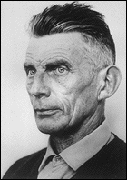
figure 4: Samuel Beckett
Tracks Four & Five: Medley -- "Consistent Oxymoron: When Is a Non-space a Space?"
[17] This dialectic of disintegration and integration, dislocation as the creation of new locations, draws attention to the recombinant nature of a poetics apposite to the age of decentred networks and telesthesia. Connectivity is what digital technology is all about and so too is recombination, or remediation, to use Jay Bolter and Richard Grusin's useful term. [5] Dislocation is temporal, as we have seen so far, but it is also spatial. The digital age has been predominantly focused on the spatial dimension of recombinant, connective technologies, a preoccupation crystallized in the totemic cyberspace of the computer network. We hear precious little, unfortunately, of cybertime. As a spatial utopia or nowhere, cyberspace resounds with the cache of novelty. There has been insufficient attention to the temporal dimension not only of cyberspace, broadly defined in terms of computer mediated communications, but also of virtual environments, which involve a profound and complex form of temporality. The idea of the virtual space as a non-space, yet a space of navigation, contemplation and immersion, can be likened to a kind of hibernation, in terms of temporality, as any linear progression of time is warped or distorted by the lack of definable co-ordinates or sequences that one actually has to follow or traverse. I'm thinking here of something like Char Davies' Osmose or Melinda Rackham's Empyrean (exhibited as part of the Under_score exhibition hosted by the Brooklyn Academy of Music), [6] and even more relevantly, James Turrell's quite extraordinary installation of virtual light, Between That Seen. My experience of this work was not only a spatial one, but a profoundly temporal one, in that time seems to stand still. It is a kind of enveloping void that subsumes the senses into a kind of frozen present. The work, and in particular the title, put me very much in mind of one of the great creators of virtual space, Samuel Beckett. From Waiting for Godot to the later tele-plays, Beckett's dramatic works were subtle and troubling evocations of time and space, not conceived as a continuum, but rather as a something like a black hole: a nether zone of neither being here nor there. As Robbe-Grillet eloquently wrote of Beckett's drama, citing Heidegger, the key to his work is to be there, to be present on the stage (Robbe-Grillet, 1965, 111). But in this he only gestured to half of the drama in Beckett's theatre. The real drama resided in the problematic of there being no there, there, the space of writing, of telephony and telesthesia generally: a time space, in other words, of the perpetual present. You will all note the deliberate allusion to William Gibson's talismanic description of cyberspace from Mona Lisa Overdrive as an abstract, oxymoronic zone of problematic presence: "there's no there, there". I cite this ostensibly to evidence the importance of Beckett's pre-digital understanding of the nature of the virtual. But my other reason for doing so is to focus on the problem of the oxymoron.
[18] There's no there, there. I think Beckett would have approved of that line, though in his last years his thoughts increasingly turned to his beloved cricket and Jameson whiskey more so than cyberpunk fiction. There is considerable overlap, though, across the more discursive critical pronouncements made on behalf of the virtual and Beckett's niggardly and usually terse articulations of his own aesthetic practice. Consider the following statement of his understanding of the creative act, offered to the French publisher Georges Duthuit, in 1948:
The expression that there is nothing to express, nothing with which to express, nothing from which to express, no power to express, no desire to express, together with the obligation to express (Beckett, 1976, 103).
Ok, so what are we left with after such relentless contradiction? This was the situation facing a generation of Beckett scholars who were so baffled by irresolvable contradictions inherent in Beckett's conceptions of the relations between time and space, speech and selfhood, technology and memory, that the only way to write about his work was to do just that, write about it, around it, of it, as opposed to actively engaging with it in ways that elicited some critical understanding of it, without compromising or watering down its contradictory complexity. Out of the "fatuous clamour" of the Beckett industry emerged one text that, I would argue, articulated more than most an active engagement with this complexity; a book written by a critic more readily associated with the London Film Co-Op and the underground film scene of the late 1960s than with Samuel Beckett scholarship. In other words, a book on Beckett by a writer dislocated from one context to another.
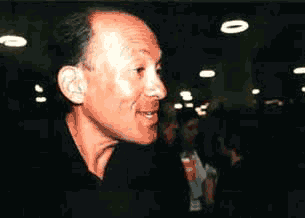
figure 5: Peter Gidal
[19] As a practitioner and theorist of materialist film, Peter Gidal described himself as someone who deals with "the inexpressible"; an aesthetic of "non-interpretive art" that he outlined in a wonderful piece published in Studio International in 1974 called "Beckett & Others & Art: A System" (Gidal, 1974, 183). This piece is prefaced by Wittgenstein's dictum that "What expresses itself in language, we cannot express by means of a language. What can be shown, cannot be said". These severe restrictions on the translatability of the expressible, on the presentable and the representable, are suggestive of the rigours of Beckett's work. "What am I to do, what shall I do, what should I do, in my situation, how proceed?" asks the narrator of the third novel of Beckett's trilogyThe Unnamable: "By aporia, pure and simple?" is the uncertain response, "Or by affirmations and negations invalidated as uttered". It was this oxymoronic tension that had eluded most of Beckett's commentators. In wanting to "accommodate the mess", to use Beckett's own term, without resolving its relentless contradictions of subjectivity, enunciation and presence, Gidal exploited in his 1986 book Understanding Beckett a quality that had been the hallmark of his writings on materialist film: a quality that his colleague Deke Dusinberre called "consistent oxymoron" (Dusinberre, 1977). In a 1977 article published in Screen, Dusinberre described Gidal's "rhetorical strategy" in terms of a dislocated, disjointed style of writing of idiosyncratic rhythms, repetition, contradiction, obsessive interpolation and intrusive quotation. The overall effect, in Dusinberre's words, is a "fragmentary composite of subjective voices" (81). Such a description effectively accounts for the style ofUnderstanding Beckett. On the basis of a mimetic conception of criticism aspiring to cogency, analysis and argumentation, Understanding Beckett is unreadable, opaque and tortuous. The entire book (250 pages, excluding notes) is a sustained collage of fragmented quotation, comprising Beckett's writing (principally his dramatic works), theoretical and polemical writings and a miscellany of annotated typescripts, reported conversations, letters and photographs. It is perhaps more accurate to describe it as intermedia or mixed-media art than criticism; or more specifically, as Susan Sontag had said of Godard's films, an art work doing the work of an essay: one medium doing the work of another, or, remediation, by any other name. Moreover, along with Ted Nelson's key manual of hypermedia theory, Literary Machines, Understanding Beckett eschews any authorized or linear way of being read. "As with many books", Gidal notes in the Introduction, all of three lines, "it might be useful not to start at the beginning. Perhaps Chapter XVIII or XX, and certainly the Notes (pp.251-78). Then from p.1".
[20] Theoretically, Gidal's book is a kind of indirect free style, or imitative form, that puts into play the very problematics of subjectivity and expression at work in the object of his critical attention. Mark Dery has described "buzz saw strumming" as the objective correlative of cyberpunk music (Dery, 1996, 95). Understanding Beckettcan be read as an objective correlative of the adjacency, connection and juxtaposition that I have been outlining in relation to Zorn, Stalling and Captain Beefheart, in the context of an aesthetics of dislocation.
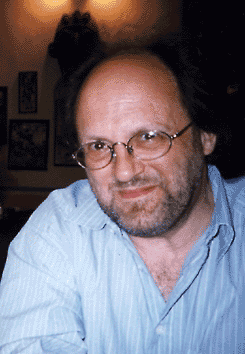
figure 6: Nicholas Zurbrugg
Track Six: The Zurbrugg Effect
[21] Now you may well by now be asking yourselves what the hell any of this stuff has to do with new media. One response to such a question is to assemble a list of proper names used throughout this tape in the manner of Stanley Fish and set you all an exercise in new media response theory: how to recognize a hypertext when you see one. Another is to note that it is very difficult to totalize new media as a coherent or singular thing. The term new media can apply to things as diverse as the use of email, digital imaging, multimedia games, hypertext fiction, non-linear editing, digital cinematography and text messaging. It would be folly to attempt to contrive a poetics that somehow accounted for these diverse applications that all fall under the banner of new media.
[22] What I have rather tried to do here is to identify a poetics that can account for the connective aspect of new media, from remote communications and the creation of virtual communities, to the radical paratactics of hypertext fiction. In other words, phenomena of dislocation associated with new media that are co-evolutionary with forms of cultural production in pre-digital media. Nor have I simply identified precursory examples of disjunctive poetics that can be pointed to as precedents, or forecasts of digital media (though Joyce came pretty close in Finnegans Wake to being a soothsayer of the digital age with the line "Speak to us of emailia"). What I have tried to do is something very much in the spirit of what I call the Zurbrugg effect.
[23] In The Parameters of Postmodernism, Zurbrugg convincingly argues that the emergence of hypermedia art practices, which he defines as the postmodern avant-garde, are "quintessentially technological innovations" that contribute to a continuation of the "European modernist avant-garde's explorations of kinetic and electronic art" (Zurbrugg, 1994, 133). This remark, in itself, is an adequate counterpoint to the speculations I have been positing. However Zurbrugg's elegant and rigorous genealogies of avant-continuity offers a persuasive insight into the deeper poetics at work in this continuum: a poetics of subtle, deep structure that may not at first appear apparent in the performative manifestations of varied art works in different media in different historical moments; manifestations as diverse as the French new novel, the performance art of Laurie Anderson, the concrete poetry of Henri Chopin, or the digital realms of Troy Innocent. The historical dimension of this poetics is detailed in one of his finest essays, "Beyond Beckett: Reckless Writing and the Concept of the Avant-Garde Within Post-Modern Literature", a version of which was first published in Art and Text in 1981 (I note the date to evidence that Zurbrugg was writing of traditional and intermedia arts that pre-dated the art forms that for our purposes are referred to as new media). In this essay Zurbrugg draws on Walter Benjamin's discussion of avant-garde art and technological change and Andreas Huyssen's account of the contemporary avant-garde as the re-articulation of an earlier avant-scene. From this discussion Zurbrugg outlines a theoretical model that accounts for the ongoing potential of new modes of creativity to emerge out of the apparent impasse of avant-garde experimentation. In other words, Zurbrugg constructs a trans-historical rather than epochal model of the avant-garde. In response to Benjamin's alignment of new forms of creativity with "a changed technical standard", Zurbrugg suggests that
The key word in Benjamin's phrase is of course changed, since the singular characteristic of contemporary technological avant-garde creativity is not so much that it employs the familiar potential of the popular mass culture to which Huyssen refers, but that it relentlessly explores the unfamiliar potential of contemporary media by juxtaposing them or by modulating them in experiments which frequently anticipate effects which, in Benjamin's terms, may only be fully achieved in the future with the advent of a changed technical standard (Zurbrugg, 1981, 41).
Zurbrugg's argument is that unfamiliarity, or novelty, is generated through the juxtaposition of existing cultural technologies. This idea converges neatly with more recent theories of new media that draw on their recombinant nature, their remediation of available media into new, hybrid forms (although I don't agree entirely with the implication that particular forms of experimentation could only be achieved with the advent of the right technology: that's an argument for another time). While these forms may present us with creative modes that seem revolutionary, in the context of Zurbrugg's argument they are actually co-evolutionary, continuing a poetics of radical displacement and experimentation that has driven the avant-garde sensibility. To exemplify this, we may well find Shelley Jackson's Patchwork Girl or Mark Amerika's Grammatron inventive and avant-garde. But we should not forget that the digital nature of hypertext, as a new technology, is not the same as hypertextuality, which can be defined, as Espen Aarseth has done, as a form of textual behaviour that is not exclusive to electronic hypertext. [7] As we elevate such works to canonical status in the pantheon of new media, we should spare a thought for all the examples of hypertextuality that are still largely unread and apparently unknown to those critics for whom hypertextuality begins with hypertext. This, then, is the Zurbrugg effect, the recognition that what we call new media art is part of a continuum, a co-evolutionary avant-garde that encompasses all modes of cultural production, including non-electronic, partly-technological works: works that have and continue to bug most people.
© Darren Tofts, February 2003.This essay was originally presented at the (Dis) Locations symposium on new media art, Cinemedia at Treasury Theatre, Melbourne, 1st December, 2001. It was originally published in Senses of Cinema, 18, January-February, 2002: «http://www.sensesofcinema.com/».
Endnotes
[1] The title of this paper comes from Captain Beefheart's "Sam With the Showing Scalp Flat Top", from the Frank Zappa/Captain Beefheart album, Bongo Fury (1975).
[2] The phrase is H. Porter Abbott's, from an article on Samuel Beckett, "A Grammar For Being Elsewhere",Journal of Modern Literature, 6, 1, 1977.
[3] This line is attributed to Frank Zappa between tracks on Trout Mask Replica.
[4] See Samuel Beckett, "Dante... Bruno. Vico.. Joyce", in Samuel Beckett et.al., Our Exagmination Round His Factification For Incamination of Work In Progress, London, Faber, 1972.
[5] See Jay David Bolter and Richard Grusin, Remediation: Understanding New Media, Mass.: MIT Press, 1998.
[6] See «http://www.bam.org».
[7] See Espen Aarseth, Cybertext: Perspectives on Ergodic Literature, Baltimore, Johns Hopkins University Press, 1994, p.5.
References
Bangs, L. (1969) Review of Trout Mask Replica, Rolling Stone, 26th July.
Beefheart, Captain (Don Van Vliet) (1969) Trout Mask Replica, Straight Records, STS1053.
Beckett, S. (1976) Proust and Three Dialogues with Georges Duthuit, London, John Calder.
Deleuze, G & F. Guattari (1987) A Thousand Plateaus. Capitalism and Schizophrenia, trans. B. Massumi, Minneapolis, University of Minnesota Press.
Dery, M. (1996) Escape Velocity: Cyberculture At The End of the Century, New York, Grove Press.
Dusinberre, D. (1977) "Consistent Oxymoron -- Peter Gidal's Rhetorical Strategy", Screen, 18, 2.
Gablik, S. (1995) Conversations Before the End of Time: Dialogues on Art, Life Spiritual Renewal, New York, Thames & Hudson.
Gidal, P. (1974) "Beckett & Others & Art: A System", Studio International, November.
---. (1986) Understanding Beckett: A Study of Monologue and Gesture in the Works of Samuel Beckett, London, Macmillan.
Larson, D. (1969) Review of Trout Mask Replica, Zigzag, August (reproduced at http://www.beefheart.com). Accessed 19/11/01.
McCabe, N. (1995) Liner Notes, The Carl Stalling Project, Volume 2, Warner Bros. Records, 945430-2.
McNeilly, K. (1995) "Ugly Beauty: John Zorn and the Politics of Postmodern Music", Postmodern Culture, 5, 2, «http://muse.jhu.edu/journals/postmodern_culture/v005/5.2mcneilly.html». Accessed 20/11/01.
McQuire, S. "Space for Rent in the Last Suburb", in Tofts, et.al., 2002.
Pound, E. (1973) ABC of Reading, London, Faber & Faber.
Robbe-Grillet, A. (1965) For A New Novel. Essays on Fiction, New York, Grove Press.
Stalling, C (1995) The Carl Stalling Project, Volumes 1 & 2, Warner Bros. Records.
Seigal, B. (1983) Review of Trout Mask Replica, Los Angeles, 25th March (can be accessed at http://www.beefheart.com/datharp/reviews/troutrev.htm. Accessed 19/11/01.
Sherill, J. «http://www.beefheart.com/datharp/albums/tmr.htm» (Accessed 19/11/01).
Tofts, D & M. McKeich (1998) Memory Trade: A Prehistory of Cyberculture, Sydney, Interface Books.
Tofts, D. (1999) Parallax. Essays on Art, Culture and Technology, Sydney, Interface Books.
Tofts, D., A. Jonson & A. Cavallaro, eds, (2002) Prefiguring Cyberculture: An Intellectual History, Sydney, Power Publications/Cambridge, MA, MIT Press.
Yellowlees Douglas, J. (1994) "'How Do I Stop This Thing?': Closure and Indeterminacy in Interactive Narratives", in Landow. G., Hyper/Text/Theory, Baltimore, Johns Hopkins University Press.
Wark, M. (1994) Virtual Geography. Living With Global Media Events, Indiana University Press.
Zorn, J. (1986) The Big Gundown: John Zorn Plays the Music of Ennio Morricone, New York, Icon, 5504.
---. (1988) Spillane, New York, Elektra/Nonesuch, 9 79172-1.
---. (1990) Naked City, New York, Elektra/Nonesuch, 9 79238-1.
Zurbrugg, N. (1994) The Parameters of Postmodernism, London, Routledge.
---. (1981) "Beyond Beckett: Reckless Writing and the Concept of the Avant-Garde Within Post-Modern Literature", Yearbook of Comparative and General Literature, 30.











No comments:
Post a Comment